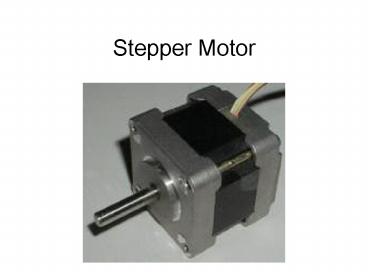Stepper Motor PowerPoint PPT Presentation
1 / 32
Title: Stepper Motor
1
Stepper Motor
2
Stator
Rotor
3
(No Transcript)
4
(No Transcript)
5
(No Transcript)
6
- Full Stepping
- Energizing one coil at a time is known as running
the motor in 'full steps'. In a 200 step motor,
this means the resolution of the motor is 200
positions for a single revolution 200 separate
rotational positions that can be achieved. Half
Stepping - There is a trick you can do to double the
resolution of the motor instead of just
energizing one coil at a time in order,
7
you can create positions inbetween by energizing
the next coil in the sequence, before
de-energizing the current coil. This also makes
for smoother motion at slower speeds. Stepper
motors can be controlled with bipolar techniques,
to strengthen the motor's ability to turn, and to
lock. Rather than energizing single coils, one is
energized with a positive voltage, while the
opposite coil is given a negative voltage.
Running a motor using bipolar techniques does NOT
affect the resolution of the motor, only power
and maximum running speed. Here's an animated
diagram showing a bi-polar half-step sequencing
technique. Note that there are 8 half steps to
this sequence. The rotor shaft is in the center,
and is a fixed magnet. The four coils around it
are energized in the order shown to achieve shaft
rotation
8
(No Transcript)
9
(No Transcript)
10
(No Transcript)
11
Stepping Sequence
- Full step sequence showing how binary numbers can
control the motor
- Half step sequence of binary control numbers
12
Full Stepping
- Animation shows how coils are energized for full
steps
13
(No Transcript)
14
Single
15
Dual
16
Both
17
(No Transcript)
18
(No Transcript)
19
(No Transcript)
20
(No Transcript)
21
Full Stepper Motor
- This animation demonstrates the principle for a
stepper motor using full step commutation. The
rotor of a permanent magnet stepper motor
consists of permanent magnets and the stator has
two pairs of windings. Just as the rotor aligns
with one of the stator poles, the second phase is
energized. The two phases alternate on and off
and also reverse polarity. There are four steps.
One phase lags the other phase by one step. This
is equivalent to one forth of an electrical cycle
or 90.
22
Half Stepper Motor
- This animation shows the stepping pattern for a
half-step stepper motor. The commutation sequence
for a half-step stepper motor has eight steps
instead of four. The main difference is that the
second phase is turned on before the first phase
is turned off. Thus, sometimes both phases are
energized at the same time. During the half-steps
the rotor is held in between the two full-step
positions. A half-step motor has twice the
resolution of a full step motor. It is very
popular for this reason.
23
Stepper Motors
- Some stepper motor uses permanent magnets. Some
stepper motors do not have magnets and instead
use the basic principles of a switched reluctance
motor. The stator is similar but the rotor is
composed of a iron laminates.
24
Application Examples
Film Advance
25
Telescope Drive
26
Labeling Machine
27
Moving Positioning System
28
Rotating Tube Cutter
29
(No Transcript)
30
(No Transcript)
31
(No Transcript)
32
(No Transcript)

